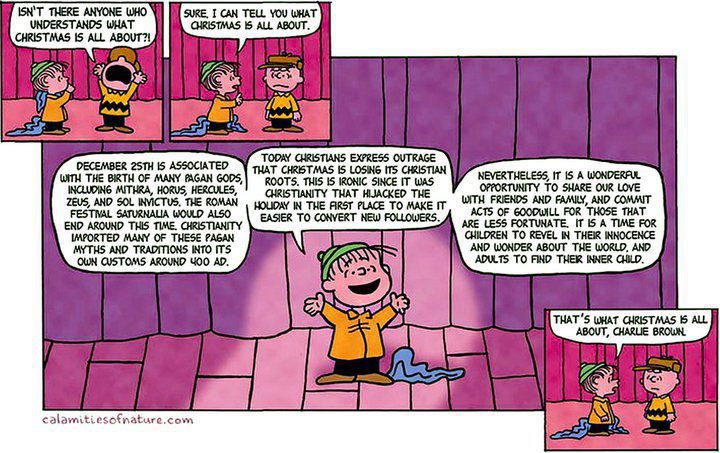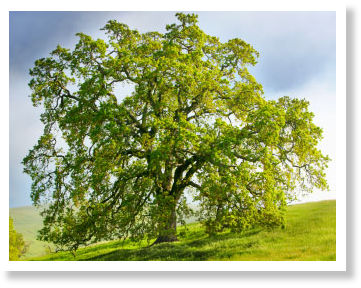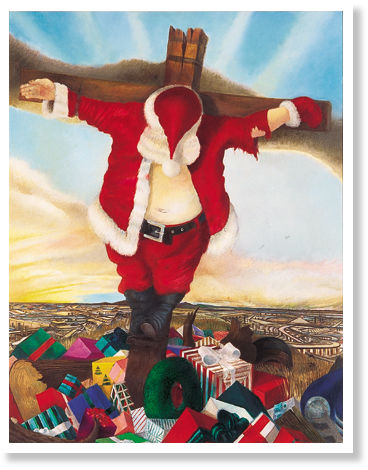This situation gave rise to thoughts of Christmas traditions as we know them today and how they began. What's the story behind the Christmas tree? Going a step further than Virginia O'Hanlon, I wondered if Santa was really an actual person. In short, why is Christmas - Christmas? Perhaps with some digging, we can get a bit closer to the truth.
It's Coming On Christmas, They're Chopping Down Trees
Many ancient societies held veneration for plants and trees. One of those was the Druids who considered the tree (specifically the oak) a symbol of sacred wisdom and renewal of life. In the book, The Druids, A Study in Keltic Prehistory by Thomas Downing Kendrick, it is mentioned that mistletoe was considered especially sacred because although rarely seen, it's found on the oak. It's is also conjectured that mistletoe has a propensity to grow when the oak is struck by lightening. The truth, however seems to be that the plant's seeds are dispersed either in the dung or the sticky seeds are rubbed on trees via the beaks of passing birds which were considered to be messengers of the gods.
Decking the Halls: The Folklore and Traditions of Christmas Plants by Linda Allen states that mistletoe, a semi-parasitic plant that makes its home in trees, was viewed as a protector of evil spirits by the Druids. It was used in rites by them during Winter Solstice and the tradition of kissing under it goes back to the Roman era when enemies reconciled under it.
The legend of the Christmas tree itself goes back to the 7th Century when a monk from Crediton, Devonshire (present-day England), looking to spread the word of God, went to Thuringia - a small town in Germany known for its lush forests. It is said that he compared the fir tree to the holy trinity and was instrumental in converting people into revering the fir tree as God's tree, whereas before the oak was preferred. By the 12th century, it was being hung upside down as a symbol of Christianity in Central Europe. Depending upon the source, some think it was St. Boniface who chopped down an oak tree worshiped by pagans and named a fir growing among the roots of the oak. This fir was seen as a symbol of Jesus.
In the mid-16th century, the first evidence of Christmas markets comes from Strasbourg, France, while in 1601 a visitor recorded seeing a decorated tree. It's said that the earliest trees were symbolic of the Tree of Paradise in the Garden of Eden.
These last two paragraphs remind me of this passage in the Cassiopaea Glossary:
The religion and intellectual life of the Celts were overseen by priest-scholars called Druids. It could be said that the religion of the Celts taught by the Druids was a religion of Ethics, Nature and Knowledge - i.e. a science - and one with a rich mythology that included the idea of transmigration of the soul (reincarnation). The Celts revered Nature, understood the cyclical nature of existence, and were initially worshippers of the Goddess - the Creative Principle (until these ideas were almost totally supplanted by the patriarchal worldview of Christianity as brought by the Romans). The woodlands, streams and lakes were their "temples". Holly, mistletoe and groves of oak trees in particular were considered sacred. To them, the Divine was everywhere and in everything. It could not be confined within a man-made structure.Latvia has also been credited with having the first Christmas tree. What's interesting is that both of these societies had pagan peoples. It sounds as if these legends may really be symbolic of the co-opting of sacred ideas - a vilification of the Divine - into a manifestation of the materialistic. Much of what Christmas has become today reflects this thought.
Because both societies (as well as others) revered the oak as a sacred tree, perhaps it's no coincidence that the dismantling of these groups and their 'controversial' ideas were required in order to contain or more specifically destroy crucial knowledge.
Sowing the Seeds
It seems that the tree was popularized via various factions of the monarchy:
The Christmas tree first came to England with the Georgian Kings who came from Germany. At this time also, German Merchants living in England decorated their homes with a Christmas Tree. The British public were not fond of the German Monarchy, so did not copy the fashions at Court, which is why the Christmas Tree did not establish in Britain at that time. A few families did have Christmas trees however, probably more from the influence of their German neighbors than from the Royal Court.The idea of the tree as a status symbol took off and people, in an attempt to emulate the wealth and prosperity of the monarchy, piled on the decorations. Eventually, the custom continued into the Victorian era. After a few fits and starts - one being the death of Queen Victoria - it regained popularity again in the 1930s:
The decorations were Tinsels, silver wire ornaments, candles and small beads. All these had been manufactured in Germany and East Europe since the 17th century. The custom was to have several small trees on tables, one for each member of the family, with that persons gifts stacked on the table under the tree.
In the 1930s there was a revival of Dickensian nostalgia, particularly in Britain. Christmas cards all sported Crinoline ladies with muffs and bonnets popular in the 1840s. Christmas Trees became large, and real again, and were decorated with many bells, balls and tinsels, and with a beautiful golden haired angel at the top. But wartime England put a stop to many of these trees. It was forbidden to cut trees down for decoration, and with so many raids, many people preferred to keep their most precious heirloom Christmas tree decorations carefully stored away in metal boxes, and decorated only a small tabletop tree with home-made decorations, which could be taken down into the shelters for a little Christmas cheer, when the air-raid sirens went.In the 18th and 19th centuries, the tree was introduced gradually in different areas of the United States via German Hessian Soldiers and cattle Barons that came to America. It has been popular ever since.
Large trees were erected however in public places to give morale to the people at this time.
Postwar Britain saw a revival of the nostalgic again. People needed the security of Christmas, which is so unchanging in a changing world, as one of the symbols to set them back on their feet. Trees were as large as people could afford. Many poorer families still used the tabletop Goosefeather trees, Americas Addis Brush Trees were being imported into Britain, and these became immensely popular for a time. But the favorites were still real trees. The popular decorations were all produced by a British manufacturer, Swanbrand. and sold by FW Woolworth in Britain. Translucent plastic lock together shapes, Honeycomb paper Angels, 'glow-in the -dark icicles; also Polish glass balls and birds In South Wales, where real trees were often difficult to find in the rural areas, Holly Bushes were decorated.
Quelling the Mass
The history of candy canes dates back to 1670 when a choirmaster in Cologne, Germany, seeking to keep children still while in church, would hand out sticks of sugar. Eventually, he thought it would be a good idea to bend one end of the 'cane' in a shepherd's crook. This idea spread throughout Europe and America.
In 1847, August Imgard, a German-Swedish immigrant living in Wooster, Ohio, is credited with first using candy canes at Christmas when he decorated a tree with them.
At the turn of the 19th century, the candy canes as we know it were adorned with red stripes and peppermint flavor was added.
Nothing like plying youth with candy to get them to sit still for programming...
The Personification of Beliefs
This depends on the source. One states that the story is a Christianization of Pagan myths:
His legend seems to have been mainly created out of myths attributed to the Greek God Poseidon, the Roman God Neptune, and the Teutonic God Hold Nickar. "In the popular imagination [of many Russians] he became the heir of Mikoula, the god of harvest, 'who will replace God, when God becomes too old.' "Another source states that he was a Bishop who lived in Turkey in the 4th century and performed miracles for sailors and children. This led to him becoming a patron Saint after his death and was given the date of December 6th to honor him. During Nicholas' life, Pope Julius I established a day to remember the birth of Jesus. Because the actual time of year of Jesus' birth was unknown, Pope Julius is said to have chosen December 25th.
When the church created the persona of St. Nicholas, they adopted Poseidon's title "the Sailor." They seem to have picked up his last name from Nickar. Various temples of Poseidon became shrines of St. Nicholas. 1 "In medieval England... in tiny sea ports we find the typical little chapel built on an eminence and looking out to sea." St. Nicholas also adopted some of the qualities of "The Grandmother" or Befana from Italy. She was said to have filled children's stockings with gifts. Her shrine at Bari was also converted into a shrine to St. Nicholas.
Over time, St. Nicholas' feast day became associated with Christmas.
Perhaps the legend is some combination of both histories? However this it all started, it seems to have been given a makeover in order to promote religion in the past through the birth of Saint Nicholas and more recently commercialism in America via 'Santa'. Both seemed to distort the idea of having enough into having more than is needed.
I find it interesting how in just these few examples we see how the the ideas of some were usurped by others. As always, we should ask, "Who benefits?" I think we all know the answer to that one by now.
When I see the changes made from cultures who had reverence for the life of trees to the dressing up of a dead one, from celebrating a season to celebrating a spectacle, it makes me think about how we seem to become so easily enamored of placing ourselves in the position of God. Our never-ending need to deny others what we want for ourselves is saddening to say the least. Will we ever learn? I hope I am.
This year will be my first Christmas in a long time (if ever) with my Dad and I'm looking forward to it. For that reason, as well as the uncertainty of future Christmases, I've decorated the tree, wrapped gifts, etc. In our case though, it will be a celebration without the madness. People spending time with those they care about. Just as it should be.
Source:
- Barbara G. Walker, The Woman's Encyclopedia of Myths and Secrets. Harper & Row, (1983) Pages 725 to 726.






Bringer of Light for the Epiphany of Truth.
With Amens and Hosannas heard neither here, nor there,
he takes a silent bow and exits stage right.
But, alas, before the curtain falls,
it is prophesized that he will return once more,
with the Magi, bringing his gifts of everlasting humility
which so few have learned to love thus far.
Magical manna awaits our lips like the morning's dewy mist.
So better luck next year Charlie Brown.
Don't forget to turn out the lights.